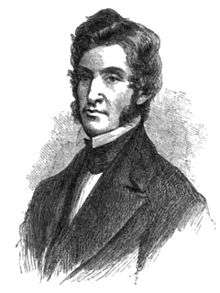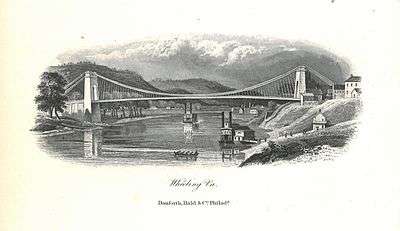Charles Ellet Jr.
Charles Ellet Jr. (1 January 1810 – 21 June 1862) was an American civil engineer who designed and constructed major canals, bridges, river improvements and railroads before the American Civil War. He also advocated using steam-powered vessels in naval warfare, volunteered to serve in the U. S. Army Corps of Engineers, received a commission as colonel and (commanding one of the new ram vessels he designed) became the only casualty (and fatality) during the Union naval victory at the Battle of Memphis.
Charles Ellet Jr. | |
|---|---|
 | |
| Born | January 1, 1810 |
| Died | June 21, 1862 (aged 52) Battle of Memphis |
| Occupation | Engineer |
| Known for | Championing suspension bridges and other engineering endeavors in United States |
Early and family life
Ellet was born at Penn's Manor in Bucks County, Pennsylvania, son of Charles Ellet Sr. and Mary Israel. His brother Alfred W. Ellet also became a civil engineer and later a brigadier general in the Union Army during the Civil War.[1] Their grandfathers on both sides served in the American Revolutionary War. Their maternal grandfather, Israel Israel, was a member of Pennsylvania's Committee of Safety and a recognized active patriot.
Ellet married Elvira Augusta Stuart Daniel on November 7, 1837 in Lynchburg, Virginia. Her father was Virginia justice William Daniel and her mother was Margaret Baldwin. Her family was one of the First Families of Virginia and owned enslaved persons, although Ellet would not. Judge Daniel's father had served as an ensign during the Revolutionary war under Captain Arda Allen, and his wife's maternal grandfather Dr. Cornelius Baldwin had served as a surgeon for the patriot cause throughout the conflict.[2] The Ellets' Virginia-born daughter, Mary V. Ellet Cabell, helped found the Daughters of the American Revolution and became its member n. 6.[3] Their son Charles Rivers Ellet also served as a colonel in the Union Army.
Early career and education

Ellett worked as a rodman, measuring for the Chesapeake and Ohio Canal and making drawings. Benjamin Wright promoted him to Assistant Engineer of the Fifth Residency, but in 1830, he resigned to continue his studies in Paris.[4]
Charles Ellett studied civil engineering at École nationale des Ponts et Chaussées in Paris, France, and in 1832 submitted proposals for a suspension bridge across the Potomac River.[5] In 1842, he designed and built the first major wire-cable suspension bridge in the United States, spanning 358 feet over the Schuylkill River at Fairmount, Philadelphia, Pennsylvania.[6] He designed the record-breaking Wheeling suspension bridge over the Ohio River at Wheeling, West Virginia in 1848, and a 770-foot suspension footbridge at Niagara Falls at the same time.[7]
His other civil engineering accomplishments include supervising both the James River and Kanawha Canal in Virginia and the Schuylkill Navigation improvements in Pennsylvania (1846–47),[8] He also constructed railroads in those states. Ellet developed theories for improving flood control and navigation of mid-western rivers.[9] In 1849 he had advocated the use of reservoirs, built in the upper reaches of drainage basins, to retain water from the wet season that could be released during periods of low water to improve navigation;[10] to some degree this also would tend to lessen the level of flooding during high flow.
In 1850, the Secretary of War, conforming to an Act of Congress, directed Ellet to make surveys and reports on the Mississippi and Ohio Rivers with a view to the preparation of adequate plans for flood prevention and navigation improvement. His very complete report had considerable influence on later engineering thought and navigation improvements.[11] His Report of the Overflows of the Delta of the Mississippi River helped to reshape New Orlean's waterfront. George Perkins Marsh published Man and Nature fourteen years later, but it was Ellet who first noted in writing that the artificial embankments created an overflowing delta. However, only decades later would his assertions be taken seriously and used in flood control decisions.[12]
Military designs, service and death
In September 1854, the 250-ton SS Vesta accidentally rammed and sank the 2,794-ton SS Arctic. This incident convinced Ellet that with the development of steam propulsion, ramming would be a very effective form of naval combat. He was unable to persuade the U.S. Navy of this, so he published the pamphlet Coast and Harbor Defenses, or the Substitution of Steam Battering Rams for Ships of War in late 1855, hoping to gain the interest of the public.
When the Civil War broke out, Ellet renewed his advocacy. The Navy still ignored him, but in March 1862, Secretary of War Edwin M. Stanton, familiar with his work on the Wheeling Suspension Bridge among other projects appointed Ellet colonel of engineers, and authorized him to form the United States Ram Fleet on the Mississippi River. Ellet converted several river steamers to rams, and by June his fleet was ready. As captains of the other rams, he appointed his brothers, his nephews, and his son Charles Rivers Ellet.
On June 6, Colonel Ellet led the rams in the Battle of Memphis as captain of USS Queen of the West. During this complete Union victory, Queen of the West and Monarch both rammed and sank the Confederate flagship CSS Colonel Lovell. Ellet was wounded during the battle—the only Union casualty. He died of his injuries in a hospital in Cairo, Illinois 15 days later.[14]
Partial bibliography
- An Essay on the Laws of Trade (Richmond: P. D. Bernard, 1839). Accessed at Haithitrust.
- A popular exposition of the incorrectness of the tariffs of toll in use on the public improvements of the United States. 1839. Philadelphia: C. Sherman & Co.. Accessed at Haithitrust.
- Exposition of the causes which have conduced to the failure of many railroads in the United States. (1841) Accessed at Haithitrust.
- The Reading Railroad Company. New-York, 1845. Accessed at Haithitrust.
Legacy
Ellet's remains were returned to Philadelphia and buried in historic Laurel Hill Cemetery overlooking the Schuylkill River.[15] The U.S. Navy named a destroyer to honor the Ellet family. USS Ellet (DD-398) was in service in 1939-46 during World War II.
References
- Eicher, John H.; Eicher, David J. (2001). Civil War High Commands. Stanford University Press. p. 224. ISBN 0-8047-3641-3.
- "Cornelius Baldwin (abt.1754-abt.1826) | WikiTree FREE Family Tree". www.wikitree.com. Retrieved September 9, 2019.
- National Society of the Daughters of the American Revolution 1901

- Unrau, Harlan D. (2007). Historic Resource Study: Chesapeake & Ohio Canal (PDF). Hagerstown, Md.: U.S. Department of the Interior, National Park Service, Chesapeake & Ohio Canal National Historical Park. p. 16. LCCN 2007473571. Archived (PDF) from the original on 2015-07-14. Retrieved 2013-05-02.
- Lewis, Gene D. (1968). Charles Ellet Jr.: The Engineer as Individualist. University of Illinois Press. p. 20.
- Steinman, D. B. & S. R. Watson. 1957. Bridges and their builders. New York, Dover Publications. p.210
- Steinman & Watson, p. 211
- Appletons' annual cyclopaedia and register of important events of the year: 1862. New York: D. Appleton & Company. 1863. p. 412. Archived from the original on 2015-11-21.
- Lewis, Gene D. (1968). Charles Ellet Jr.: The Engineer as Individualist. University of Illinois Press. pp. 36, 92.
- Timeline: Development of US Inland Waterways System from Coosa-Alabama River Improvement Association, Inc.
- "Federal Participation in Waterways Development". Archived from the original on December 30, 2011. Retrieved September 9, 2019.
- Kelman, Ari (2003). A River and Its City: The Nature of Landscape in New Orleans. University of California Press. p. 162. ISBN 0-520-23432-4.
- Eicher, D. J. (2001). The Longest Night: A Military History of the Civil War. New York: Simon & Schuster. p. 253. ISBN 0684849445.
- Find a Grave no. 5772
Further reading
- Bell, Christopher Ross. "Charles Ellet Jr., and the theory of optimal input choice." History of Political Economy 18.3 (1986): 485-495.
- Ekelund, Robert B., and Donald L. Hooks. "Ellet, Dupuit, and Lardner: On Nineteenth Century Engineers and Economic Analysis." Nebraska Journal of Economics and Business (1973): 43-52.
- Fowler, William M. 1990. Under Two Flags: The American Navy in the Civil War. Norton and Company. ISBN 0-393-02859-3
- Hebert, Robert. (1986). Emile Cheysson and the Birth of Econometrics. Économies et sociétés. 20. 203-222.
External links
![]()